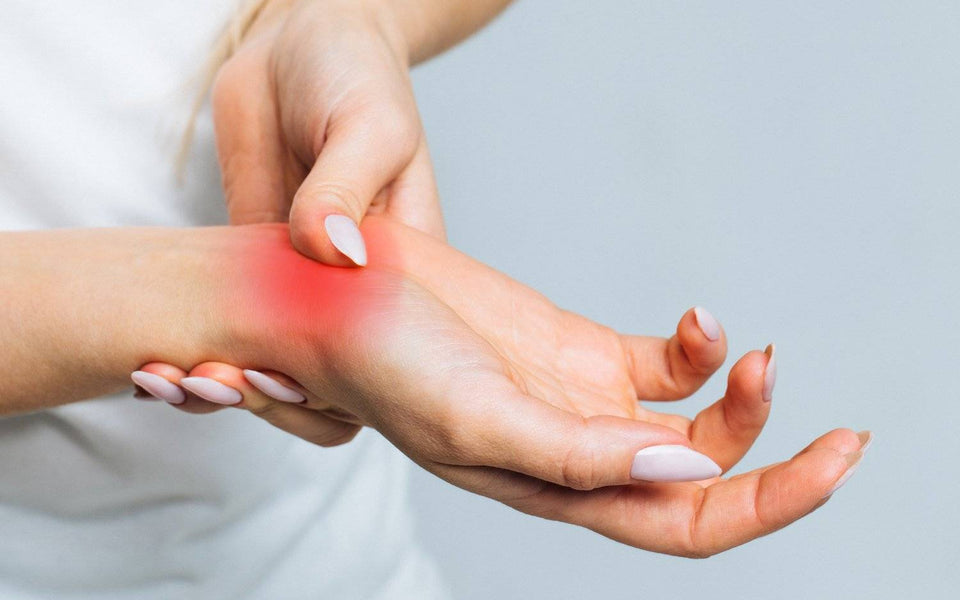According to figures from the NHS, rheumatoid arthritis affects around 400,000 people in the UK [1]. It's a long-term condition that causes pain, inflammation, and stiffness in the joints - most notably the hands, feet, and wrists. It's rarely isolated on one side of the body – if it affects one wrist for example, it'll likely affect the other one too.
It's not a ‘steady' condition where there's discomfort all the time. It's cyclical, meaning there may be periods where symptoms become worse, known as flare-ups or flares.
In this article we're going to look at evidence-based approaches to managing rheumatoid arthritis. We'll investigate what can be done to help sufferers reduce the severity of the condition and help them to lead much more normal, pain-free lives.
Time to read: 4 minutes
Key Points:
- Causes and symptoms of rheumatoid arthritis
- Current treatment approaches
- Non-medical management
- How infrared technology can help you manage the condition
- Conclusion
It's rarely isolated on one side of the body – if it affects one wrist for example, it'll likely affect the other one too.
Checkout our pain relief optionsRheumatoid arthritis – causes and main symptoms
Rheumatoid arthritis is an autoimmune disorder, which is where the body attacks its own healthy tissue [2]. At present there isn't a known cause for the condition, meaning any treatment is reactionary rather than preventative.
There are some biochemical clues as to the causes, but nothing certain. There also appears to be a strong genetic link to the condition [3]. The risk factors include age, gender, genetics, and environmental exposure to toxins (cigarette smoking, air pollutants, and occupational exposure to chemicals and fumes).
The main symptoms of rheumatoid arthritis are as follows…
- Joint pain, tenderness, and stiffness
- Inflammation in and around the joints
- Restricted movement of the joints
- Warm red skin over the affected joint
- Tiredness and a lack of energy
- High temperature
- Sweating
- Loss of appetite
- Weight loss
Some or all these symptoms may be present – it's not a condition that presents the same way in every patient. It can also vary with each flare up, so for some sufferers no two experiences are the same.
Current treatment approaches
The treatment plan is largely guided by the symptoms the patient has and the stage of the disease. For example, in the early stages anti-inflammatory and pain-relieving drugs are the go-to approach. These approaches are typically cycled up with increased dosages until they become ineffective.
At that point the approach is about trying to establish remission or slowing the progression of the disease, helping to prevent joint deformity. Medications known as DMARDs (Disease-modifying antirheumatic drugs). These come in a wide range of forms, so the nature of the treatment will depend on the individual circumstances.
In extreme cases, surgery is an option. The level of the surgery ranges from repair of damaged tissues through to a complete replacement of the joint when required. Although this isn't without risks, it's a permanent solution to a problem in a given joint. It's worth noting that replacement is only an option in certain joints though. [4]
Non-medical management of rheumatoid arthritis
Unlike many other conditions, there's an accepted take that nutritional intervention isn't especially effective. There are incidences where supplementation may have a minor impact on the disease, but not enough to justify the movement away from medicines. There's no known food that exaggerates the disease, so nothing to avoid [5].
What we know to be effective are movement and physiotherapy. Physiotherapy helps to reduce the initial pain and re-establish movement in an effective way. It also helps to educate patients about what they can/can't do and how best to cope with the condition [6].
When it comes to movement there's a chicken and egg situation ongoing with rheumatoid arthritis. Movement is often painful, so patients move less. That means muscle mass and joint mobility are lost, which makes movement more difficult and painful. A key factor in reducing the spread and severity of the condition is establishing regular, pain free movement.
Infrared technology is very effective at helping with this.
How infrared clothing helps rheumatoid arthritis symptom relief
The infrared technology used in KYMIRA Medical clothing helps to reduce inflammation and acts as a mild analgesic (painkiller). This helps to replicate the effects of medication, so allows you to exist pain-free in mild cases of RA.
Furthermore, it acts as a vasodilator, which means it improves blood flow to areas of the body. This improvement in circulation helps to maintain tissue health and promote easy, pain-free movement. This allows you to continue with your exercise without discomfort. We know that one of the most effective ways to prevent RA and help ease the symptoms is by moving regularly, so this will help to establish that.
Lots of research advocates for gym-based exercise to treat the symptoms of rheumatoid arthritis, so anything that helps you to establish an exercise regime without discomfort is a huge asset when it comes to rheumatoid arthritis symptom relief [7].
KYMIRA Medical garments are a perfect solution to the problem because they're non-medicinal and totally passive. You simply wear them and allow the technology to get to work. There are items for all different body parts and different uses, from gloves, socks, sportswear and even pyjamas. The KYMIRA Medical range (literally) has you covered!
Rheumatoid arthritis symptom relief- concluded
Whilst we know that rheumatoid arthritis is a painful condition, rest assured there are things you can do to help slow the spread and prevent the issue becoming worse. Living well, moving often, using infrared clothing and reducing your exposure to chemicals are all shown to be effective.
Expand For References[1] https://www.nhs.uk/conditions/arthritis/
[2] https://www.nhs.uk/conditions/rheumatoid-arthritis/causes/
[3] https://www.ncbi.nlm.nih.gov/pmc/articles/PMC5920070/
[4] https://www.ncbi.nlm.nih.gov/pmc/articles/PMC6422329/
[5] https://www.karger.com/Article/Abstract/493390
[6] https://www.ncbi.nlm.nih.gov/pmc/articles/PMC1395797/
